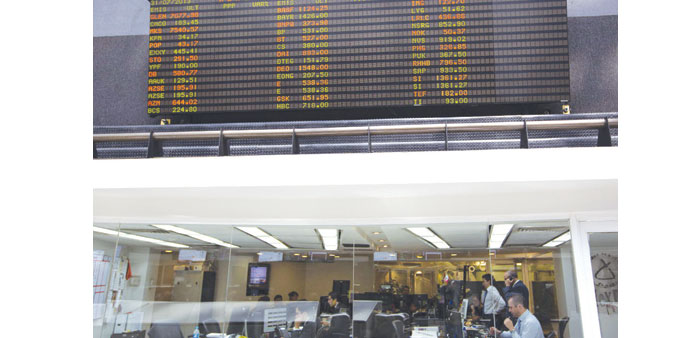Dow Jones/Sao Paulo
Investors have high hopes for Latin American stocks in 2014, after a disappointing 2013 left share prices lower across most of the region.
Stock market indexes from Mexico to Chile fell enough over the course of 2013 to offer up plenty of bargains, and weaker currencies around the region add to the potential for smart stock picking.
“It’s a good buying opportunity,” said Geoffrey Dennis, head of global emerging-markets strategy at UBS. “People are saying “It was a terrible year in 2013, it has to be better in 2014.’”
Foreign-exchange woes have piled on further misery. The region’s currencies have been losing ground against the dollar for months, with the Brazilian real weakening 15.2% last year and the Peruvian sol weakening 9.7% partly because of investor concern about the looming end to the US Federal Reserve’s $85-billion-a-month bond-buying programme.
Brazil’s benchmark Ibovespa index lost almost 16% in 2013 and in dollar terms plummeted 26%. The index’s most heavily weighted shares, iron miner Vale SA and oil company Petroleo Brasileiro SA, lost the most market value in the year, according to Economatica. Vale lost $30 billion and Petrobras lost $34 billion.
Worst hit was Peru’s IGBVL index, which dropped 23.6%, while Colombia’s IGBC fell 11.2% and Chile’s IPSA declined 14%. All three were even worse off in dollars. All stock index and currency figures were provided by FactSet.
One major market escaped some of the bloodbath. Mexico’s IPC index fell 2.2% in 2013 and retreated 3.1% in dollar terms. The Mexican peso was down a mere 1.4% against the dollar last year, helped by a series of reforms passed by the government expected to attract more investment inflows in the future. While opinion is mixed about the potential for the region as a whole this year, investors see plenty they like in individual countries, though not always in the same countries.
For Audrey Kaplan, a senior portfolio manager at Federated Investors in New York, Brazil is the only country in Latin America worth investing in at the moment.
“We have a favourable view of global equities, but are cautious about Latin America,” Kaplan said. “In Latin America we favour Brazil, primarily because Brazilian equities are cheap. The valuation is driving our view.”
The forward price/earnings ratio for Brazil’s Ibovespa index was at 10.7 on December 31, down from 19.2 a year earlier, according to FactSet. That compares with 15.4 for the S&P 500 on the last day of 2013.
The International Monetary Fund predicts GDP growth of just 2.5% in Brazil for 2014, but there are some bright spots.
One of the companies Kaplan likes is beer-maker Companhia de Bebidas das Americas SA, or AmBev. The World Cup soccer competition will be held in Brazil later this year and should help boost beer sales there, she said, and raise the tournament sponsor’s profile around the world.
In Mexico, Latin America’s second-biggest economy after Brazil, the economy should bounce back in 2014, with an expansion of 3% after 2013’s 1.2% growth rate, according to the IMF. The growth slump last year may have been tied to Mexico’s political cycle. Government spending rises ahead of a presidential election then declines rapidly afterward. Last year was no different with newly elected President Enrique Peña Nieto focusing on guiding reforms through Congress rather than on boosting short-term growth.
The biggest reform of all, the opening up of the country’s oil industry to outside investors after a seven-decade monopoly by Pemex, could start to pay off quickly.
“The oil thing isn’t getting nearly as much press as it deserves” based on the positive effect on investment it will have, said Greg Lesko a managing director at New York-based Deltec Asset Management LLC.
The next tier of Latin American economies, Chile, Colombia and Peru, will all see faster economic growth in 2014 than Brazil and Mexico, according to the IMF’s forecasts. None of the three offer the breadth of options available in Brazil and Mexico, but there may be opportunities for careful stock-pickers that can hang on to shares, said Sammy Simnegar, a portfolio manager at Fidelity Investments
Peru is a favourite among the investors and analysts. The IMF expects GDP growth of 5.7% in 2014, the second-fastest pace the organisation expects in all of Latin America after Guyana, after an expansion of 5.4% last year.
Peru’s neighbour Chile is also expected by the IMF to have fast economic growth, of 4.5% in 2014 compared with 4.4% last year. Colombia’s economic growth in 2014 will be slower than Peru’s and Chile’s, according to the IMF, but will still be an impressive 4.2%—after an increase of 3.7% last year.

Traders monitor the markets on the trading gallery of Bolsa Mexicana de Valores (BMV), Mexico’s stock exchange, in Mexico City (file). The fall in Latin American markets offers plenty of bargains to prospective investors, say analysts.


